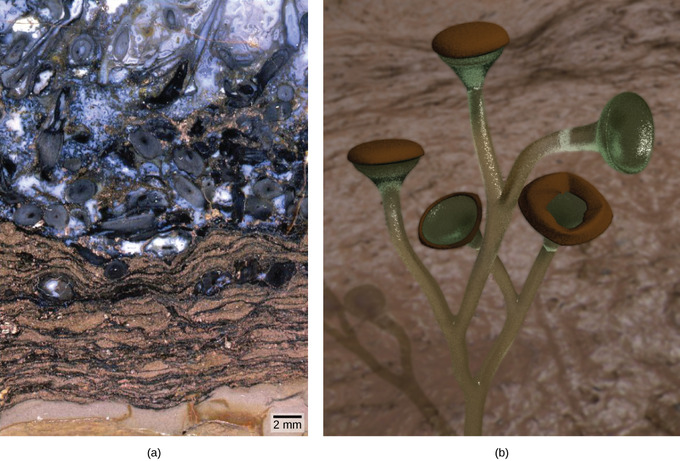25.1B: Evolution of Land Plants
- Page ID
- 13647
The geologic periods of the Paleozoic are marked by changes in the plant life that inhabited the earth.
- Summarize the development of adaptations in land plants
Key Points
- Land plants first appeared during the Ordovician period, more than 500 million years ago.
- The evolution of plants occurred by a stepwise development of physical structures and reproductive mechanisms such as vascular tissue, seed production, and flowering.
- Paleobotonists trace the evolution of plant morphology through a study of the fossil record in the context of the surrounding geological sediments.
Key Terms
- Paleobotany: the branch of paleontology or paleobiology dealing with the recovery and identification of plant remains from geological contexts
- mycorrhiza: a symbiotic association between a fungus and the roots of a vascular plant
Evolution of Land Plants
No discussion of the evolution of plants on land can be undertaken without a brief review of the timeline of the geological eras. The early era, known as the Paleozoic, is divided into six periods. It starts with the Cambrian period, followed by the Ordovician, Silurian, Devonian, Carboniferous, and Permian. The major event to mark the Ordovician, more than 500 million years ago, was the colonization of land by the ancestors of modern land plants. Fossilized cells, cuticles, and spores of early land plants have been dated as far back as the Ordovician period in the early Paleozoic era. The evolution of plants occurred by a gradual development of novel structures and reproduction mechanisms. Embryo protection developed prior to the development of vascular plants which, in turn, evolved before seed plants and flowering plants. The oldest-known vascular plants have been identified in deposits from the Devonian. One of the richest sources of information is the Rhynie chert, a sedimentary rock deposit found in Rhynie, Scotland, where embedded fossils of some of the earliest vascular plants have been identified.


Gradual evolution of land plants: The adaptation of plants to life on land occurred gradually through the stepwise development of physical structures and reproduction mechanisms
How organisms acquired traits that allow them to colonize new environments, and how the contemporary ecosystem is shaped, are fundamental questions of evolution. Paleobotany (the study of extinct plants) addresses these questions through the analysis of fossilized specimens retrieved from field studies, reconstituting the morphology of organisms that disappeared long ago. Paleobotanists trace the evolution of plants by following the modifications in plant morphology, which sheds light on the connection between existing plants by identifying common ancestors that display the same traits. This field seeks to find transitional species that bridge gaps in the path to the development of modern organisms. Paleobotanists collect fossil specimens in the field and place them in the context of the geological sediments and other fossilized organisms surrounding them.
Paleobotanists distinguish between extinct species, as fossils, and extant species, which are still living. The extinct vascular plants, classified as zosterophylls and trimerophytes, most probably lacked true leaves and roots, forming low vegetation mats similar in size to modern-day mosses, although some trimetophytes could reach one meter in height. The later genus Cooksonia, which flourished during the Silurian, has been extensively studied from well-preserved examples. Imprints of Cooksonia show slender, branching stems ending in what appear to be sporangia. From the recovered specimens, it is not possible to establish for certain whether Cooksoniapossessed vascular tissues. Fossils indicate that by the end of the Devonian period, ferns, horsetails, and seed plants populated the landscape, giving rising to trees and forests. This luxuriant vegetation helped enrich the atmosphere in oxygen, making it easier for air-breathing animals to colonize dry land. Plants also established early symbiotic relationships with fungi, creating mycorrhizae: a relationship in which the fungal network of filaments increases the efficiency of the plant root system. The plants provide the fungi with byproducts of photosynthesis.


